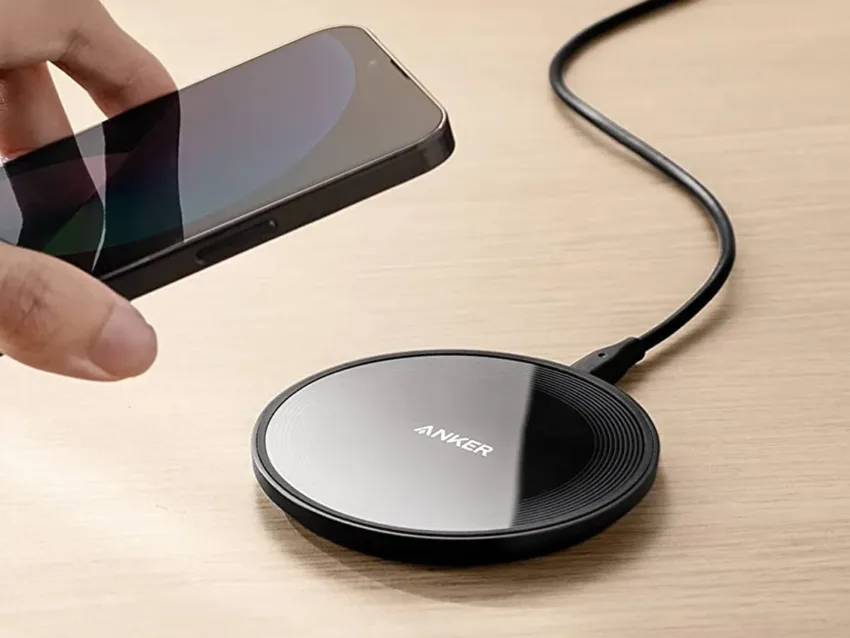Wireless chargers have surged in popularity due to their convenience and simplicity. Users appreciate the freedom from cables and the ease of simply placing their devices on a charging pad or stand. The growing adoption of wireless charging in smartphones, earbuds, and other devices has also contributed to its rise.
Advancements in charging technology, faster charging speeds, and increased compatibility across various devices have made wireless chargers more appealing to a broader audience.
Table of Contents
How Does Wireless Charging Work?
Wireless charging, also known as inductive charging, operates on the principle of electromagnetic induction. It involves a few key components to transmit power from a charging station to a device:
Charging Pad/Station
This is the base where the device to be charged is placed. Inside the charging pad, there’s a coil of wire that’s connected to an electric current source. When this current flows through the coil, it creates a magnetic field around it.
Receiver Coil in the Device:
The device to be charged (like a smartphone) has a coil of wire, often referred to as the receiver coil, designed to pick up the magnetic field generated by the charging pad.
Electromagnetic Induction
When the device with the receiver coil is placed on the charging pad, the magnetic field from the pad’s coil induces an electric current in the receiver coil of the device. This happens without any physical connection between the charging pad and the device.
Conversion and Charging
The induced electric current is then converted into usable electricity that charges the device’s battery. This charging process begins once the device recognizes that it’s placed on a compatible charging pad.
Control Mechanisms
There are control circuits in both the charging pad and the device that communicate with each other to ensure the right amount of power is being transferred and to avoid overcharging or overheating.
Similar read: What Is Cinco De Mayo
Different wireless charging standards
When choosing a wireless charger, it’s important to ensure compatibility between the charger and the device you want to charge. Most modern smartphones and devices support Qi, but it’s always a good idea to double-check compatibility to ensure efficient and safe charging.
Qi (Chee)
Developed by the Wireless Power Consortium (WPC), Qi is the most widely adopted standard for wireless charging. It operates through electromagnetic induction. Qi-enabled devices, like smartphones, tablets, and wearables, can charge on Qi-compatible charging pads or stands. Qi supports power levels up to 15 watts, enabling relatively fast charging speeds.
Powermat (PMA)
Powermat was another wireless charging standard, but it has largely phased out in favor of Qi. It used a technology called magnetic resonance to charge devices. Some older devices may still support Powermat, but most newer devices have shifted to Qi.
AirFuel Alliance (formerly A4WP and PMA)
The AirFuel Alliance supports both inductive (similar to Qi) and resonant wireless charging. It aims to create a more flexible standard that includes short-range inductive and more flexible, longer-range resonant charging. However, it hasn’t seen as much widespread adoption as Qi.
Similar read: What Is Title 42?
Factors to Consider When Choosing a Wireless Charger
A. Compatibility
Check which devices are supported by the charger. Some chargers cater to smartphones, while others support a broader range including smartwatches and earbuds. Look for Qi certification to ensure compatibility with a wide array of devices. Some chargers might specify compatibility with certain device models.
B. Charging Speed and Wattage
The charger’s wattage often influences the charging speed. Higher wattage generally means faster charging, but it’s important to note that the device being charged must also support that wattage. Fast charging capabilities vary across devices. Some chargers may support fast charging for specific models, but not all devices benefit equally from these features.
Similar read: What Is Application Software
C. Design and Form Factor
Chargers come in various styles such as stands, pads, or multi-device chargers. Choose one that suits your preferences and charging needs. Consider portability and ease of use. Some chargers might be more convenient for travel or specific locations.
D. Safety Features
Essential safety features include overheat protection and foreign object detection. Chargers with these features can prevent damage to devices and ensure safer charging experiences. It’s crucial to choose chargers that incorporate these safety measures to protect both the charger and the devices being charged.
E. Price and Brand Reputation
Balancing quality and cost-effectiveness is important. Cheaper options might lack certain features or reliability, while more expensive ones might offer additional functionalities. Consider reputable brands known for producing reliable and safe chargers. Brand reputation often reflects quality and customer satisfaction.
- What is Epic Games Launcher and How to Install It? - July 15, 2024
- What Is Audius Music Streaming App and How Does it Work? - July 13, 2024
- The 10 Best Astronomy Apps for Stargazing - July 12, 2024

